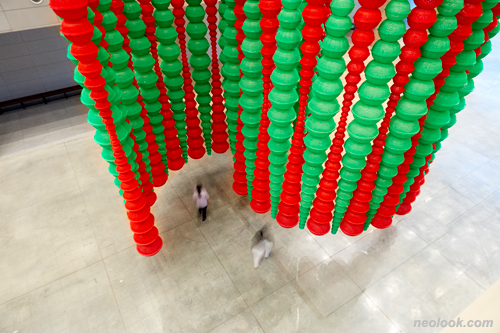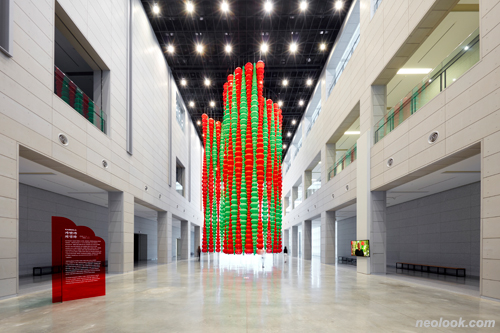- ● homepage
- ● archives
- ● restoration
- ● books
- ● big banners
- ● post board
- ■ neo's search
- ■ about us
- ■ 게재방법 안내
- 개인정보처리방침

- [email protected]
- Tel. 02_335_7922
- Fax. 02_335_7929
- 10:00am~04:30pm
- 월요일~금요일
- 3/3(월) 대체공휴일

카발라(Kabbala)
최정화展 / CHOIJEONGHWA / installation 2020_0707 ▶ 2021_0103 / 월요일 휴관
● 위 이미지를 클릭하면 네오룩 아카이브 Vol.20190329f | 최정화展으로 갑니다.
별도의 초대일시가 없습니다.
관람시간 / 10:00am~06:00pm / 월요일 휴관 사전 예약제로 운영합니다.
대구미술관 DAEGU ART MUSEUM 대구시 수성구 미술관로 40(삼덕동 374번지) Tel. +82.(0)53.803.7900 artmuseum.daegu.go.kr
대구미술관은 2020년 어미홀 프로젝트 최정화의 『카발라(Kabbala)』전시를 개최한다. 「카발라(Kabbala)」는 '눈이 부시게 하찮은 것'을 의미하고, 한국인의 어느 집에나 있을 법한 붉은색, 녹색 플라스틱 소쿠리 5,376개를 쌓아 만든 16m 설치 작품이다. 한국 현대미술 대표 작가 중 한 명인 최정화(b.1961)는 삶의 주변에 있는 다양한 사물을 수집하고, 쌓고, 조합하여 하나의 새로운 작품으로 탈바꿈 시킨다. 예를 들면 대량 생산된 싸구려 플라스틱 소쿠리, 빗자루, 실내화, 타이어, 냄비 등을 이용하여 건축적인 조각, 조형물을 만들어 내는 것이다. 공공미술까지 확대되는 최정화의 작품 세계는 팝, 키네틱, 키치적인 요소 등을 넘어서 한국인의 삶에 깃든 일상성을 극대화한다. ● 2018년 작가는 국립현대미술관 『꽃, 숲』전시에서 백성 민, 흙 토, 올 래 자를 딴 「민들레(民土來)」 작품을 선보였다. 서울, 부산, 대구 등의 시민들에게 기증받은 7,000여 개의 냄비, 찜통, 프라이팬을 이용한 본 작품은 민들레 홀씨처럼 피어난 꽃을 상징한 높이 9m, 3.8톤의 거대한 설치 작품이다. 이처럼 일상 속의 오브제들이 하나의 현대미술로 재탄생하는 최정화의 작품 세계는 '연금술'로 비유되는데, 「카발라(Kabbala)」의 어원 역시 그 의미와 맞닿아 있다. ● '카발라(Kabbala)'의 어원은 유대교 신비주의의 근본을 의미한다. 아리스토텔레스의 '4원소 변환설'을 바탕으로 값싼 물질을 금으로 바꾸려고 노력했던 연금술은 실제로 금을 만드는 것에 실패했지만 그 과정에서 여러 가지 유용한 물질들을 발견하기도 했다. 최정화 작가 역시 인간의 생활에 쉽게 접할 수 있는 '플라스틱'이 하찮게 여겨지는 것을 역이용하여 일상의 재료가 멋진 현대미술이 될 수 있음을 보여준다. 그는 일상의 사물들을 조합하여 현대미술로 전환시키면서 '생활과 예술의 구분이 나누어져 있는 것인가?','예술이란 무엇인가'와 같은 근본적인 질문을 던진다. ● 대구미술관 어미홀에서 공개되는 소장품 「카발라(Kabbala)」는 2020년 코로나19를 이겨내고 성숙한 시민의식을 보여준 대구 시민들을 위한 작품이다. 일상의 소중함이 어느 때보다 절실한 이때, 시민들이 이 작품을 통해 일상과 예술의 즐거움을 향유할 수 있는 자리가 되길 기대한다. ■ 대구미술관

- 최정화_카발라(Kabbala)_플라스틱 바구니, 철 프레임_가변설치(16m)_2013 대구미술관 소장
Daegu Art Museum holds the exhibition of CHOI Jeong-hwa Kabbala as an UMI Hall Project of 2020. Kabbala referring to "spectacularly trivial" is a 16m-tall installation work accumulated by 5,376 red and green plastic baskets that are commonly available at any Korean family house. CHOI Jeong-hwa (born in 1961), one of the most representative artists of Korean contemporary art, collects heterogeneous objects from our daily life and assembles and transform them into new art works. For instance, he creates architectural sculpture and formative works by using massively produced cheap plastic baskets, brooms, slippers, tires and pots. His art world even expands to public art maximizing everydayness deeply inherent in Korean life style beyond pop, kinetic and kitsch-like elements. ● In 2018, CHOI displayed the work Min Deul Lae (Dandelion), the acronym borrowed from the Korean words "People, soil and upcoming future" in the exhibition entitled Flowers and Forest held at National Museum of Modern and Contemporary Art. The work based on more than 7,000 pots, steamers and frying pans given by citizens from Seoul, Busan and Daegu is a huge installation work of 9 m with 3.8 tons symbolizing flowers blooming like dandelion puffs. Like this, CHOI's art world bringing everyday objects to a new life as contemporary art is often compared to "alchemy" and the etymological origin of Kabbala is in line with the significance. ● The term Kabbala finds its etymological root from Jewish mysticism. Alchemy trying to transform the inexpensive materials into gold, based on Aristotle's 'Four Elements Transformation Theory' failed to make gold but it discovered many useful materials during the process. Likewise, CHOI takes advantage of 'plastic' that is easily accessible and considered trivial in our daily life to show that such everyday materials can constitute excellent contemporary art. By combining quotidian objects, he successfully transform them into contemporary art and asks fundamental questions like 'Is there division between everyday life and art?' and 'what is the essence of art?' ● Kabbala, the collection of Daegu Art Museum, which will be unveiled at Umi Hall, is a work for citizens of Daegu who demonstrated mature citizenship overcoming COVID-19 of 2020. Preciousness of everyday life is highly valued than ever in times of pandemic, and we hope that this exhibition can provide all citizens with an opportunity of enjoying delight of everydayness and art. ■ Daegu Art Museum
Vol.20200711e | 최정화展 / CHOIJEONGHWA / installation

